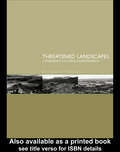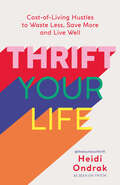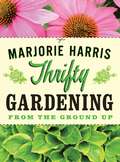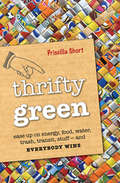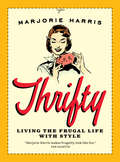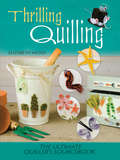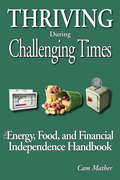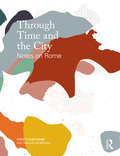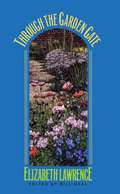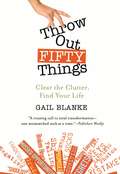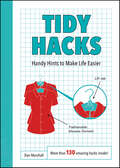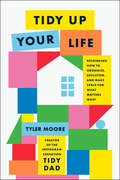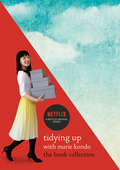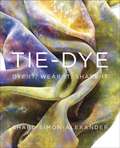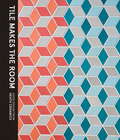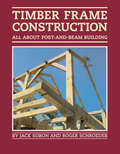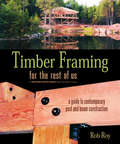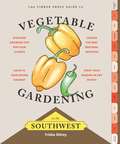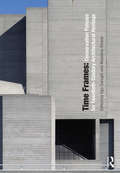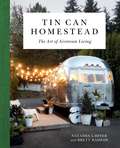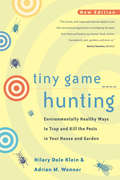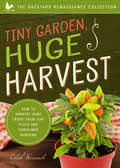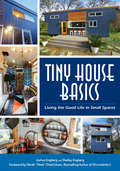- Table View
- List View
Threatened Landscapes: Conserving Cultural Environments
by Bryn Green Willem VosFew, if any, environments are free of human intervention. Often this generates ecosystems which are rich in biodiversity, historical interest, recreational opportunity and scenic beauty just as worthy of conservation as the more natural ecosystems on which protection programmes have been almost exclusively focussed.These 'cultural landscapes', ranging from the farm and forest lands of Europe and Eastern North America, through to the pasture lands and savannas of the Middle East and Africa to the paddylands of the Pacific Rim, are usually the product of relatively low-level, sustainable exploitation of the environment over long periods of time. Many have survived for centuries, if not millennia, but now urban expansion, depopulation of rural areas and, most damagingly, the intensification of agricultural and sylvicultural practices, are everywhere leading to a loss of their cherished biodiversity and amenity. Whilst past changes have mostly added to the valued characteristics of these landscapes, modern farming and forestry are creating sterile monocultures on the better land whilst marginal lands are being abandoned.This book documents these changes, illustrates them through detailed case studies of a representative selection of threatened landscapes, analyses their underlying causes and explores ways by which they can continue to be maintained, or new landscapes created which maintain their desired characteristics.
Thrift Your Life: Cost-of-Living Hustles to Waste Less, Save More and Live Well
by Heidi OndrakThe Queen of Thrift.' The Sun 'Super Saver Mum shares simple tips.' Daily MailFull of hacks and hustles to navigate those sudden changes in fortune that none of us could have predicted. This is a no-nonsense guide on how to change your habits to weather the storm, written by TikTok's queen of budgeting, Heidi Ondrak, aka The Duchess of Thrift.Life rarely follows a linear path, sh*t happens that you could have controlled better, and then stuff happens that you have absolutely no control over whatsoever, like the current cost-of-living crisis. Full of practical hacks to adapt to life's financial ups and downs and guaranteed to help you save every month, Heidi will show you how to nurture resilience alongside some of those cheeky life hacks that no one teaches in schools. Think of it as a modern-day take on Mrs Beeton's Book of Household Management, with extra sass.Hacks range from the well-versed and practical to the downright outrageous – pick and choose, do what suits you. Heidi will help you build a toolkit to get you through the crisis and feel prepared and in control for more energy increases, interest rate rises and eye-watering inflation, while doing it with a fighting spirit and sunny demeanor. You'll learn how to change your mindset, get the family on board, carry out budget health checks, shop smarter, look a million dollars for pennies, have great days out, enjoy Xmas and be able to get around... All on a shoestring!
Thrifty Gardening: From the Ground Up
by Marjorie HarrisBestselling author and gardening columnist Marjorie Harris offers a timely and entertaining guide for gardeners at every stage of life. Whether you're moving into your first apartment or condo, upgrading to a house, or downsizing to smaller digs, Harris shares the best tips on how to create a beautiful garden for any space — all on a budget. The highly anticipated sequel to her popular book Thrifty: Living the Frugal Life with Style, The Thrifty Gardener marries Harris's passion for gardening with her thrifty lifestyle savvy so that everyone can create a natural oasis whatever their living situation is — and without breaking the bank.
Thrifty Green: Ease Up on Energy, Food, Water, Trash, Transit, Stuff—and Everybody Wins
by Priscilla ShortHow one woman&’s year living off the grid made her think about conservation in a whole new way—and how to apply what she learned to your own lifestyle. Priscilla Short lived off the grid for a year in a strawbale house in Taos, New Mexico, with no electricity, no running water, and a wood-burning stove for heat. At the end of the year, Short returned home to Denver committed to making a smaller ecological footprint by consuming less and conserving more. In Thrifty Green, Short offers a unique, resource-by-resource approach that shows us that the best way to practice conservation, the real win-win, involves saving money as we lighten up. This book will help you make crucial decisions about transportation, heat, power, light, water, food, and garbage. Peppered with examples of people living both on and off the grid, eccentric and ordinary, who are deliberately making choices to live with less, Thrifty Green is much more than a how-to book. It is a conscientious guide to the art of going green that includes a wealth of terrific tips, fun facts, and straightforward strategies that will make you think about conservation in a whole new way.
Thrifty: Living the Frugal Life with Style
by Marjorie HarrisWritten in Marjorie Harris's trademark witty, engaging, and accessible style, Thrifty is chock-full of simple and savvy tips drawn from her own richly thrifty experience, and those of renowned experts such as bestselling author Margaret Atwood, actor R. H. Thomson, travel writer Sylvia Fraser, and the Globe and Mail Style columnists. With solid tips on how to haggle, how to become a frugal fashionista, maintaining home and hearth on a budget, and practical advice on thrifty gardening, travel, and entertainment, Harris provides essential guidelines to living a quality life on less.
Thrilling Quilling: The Ultimate Quiller's Sourcebook
by Elizabeth Moad"This book is an excellent sourcebook for quilling and I recommend anyone interested in paper craft to own this book." -- Doodles in the Margin ReviewsAdd pizzazz to picture frames, notebooks, vases, boxes, bags, or any everyday item that could use a decorative touch. The centuries-old craft of quilling involves rolling, shaping, and gluing strips of paper into ornamental designs. It's easy to learn, and this guide is bursting with simple, step-by-step instructions and colorful illustrations that will get you started and send you on your way with a wealth of new possibilities.From quick and easy individual motifs to larger, more elaborate combinations, here are more than 100 designs with countless applications. Quilling requires very little equipment and few materials -- just an inexpensive investment in a manual quilling tool, glue, and paper. With a little practice, you'll master the techniques of coiling, pinching, fringing, weaving, and husking. Then you'll be able to add a personal touch to cards, gifts, and other items. In addition, the book features galleries of imaginative ideas that will provide further inspiration and encourage you to develop new ideas and creative approaches.
Thriving During Challenging Times
by Cam MatherMost of us have never lived through times as tough as these. The economic crisis, peak oil, rising food costs, climate change, and water shortages have all converged to make it a very challenging time. This book provides a road map to allow you to return to the independence of previous generations: independence in how you power your home, where you get your food from, and how you control your financial destiny. The amazing thing is that the recommendations are not only good for you, they're good for the planet. Showering with water heated by the sun and eating a "one hundred foot diet" with food grown in your backyard will help you to reduce your carbon footprint. They also give you back control of your budget. By using the step-by-step guide on how to get the fastest payback and invest the money you save, you'll discover the joy of being in control again.From where you live, to how you heat and power your home, to producing your own food, controlling water, and getting your financial house in order, this book proves that money doesn't buy happiness, but using what you have wisely helps.Because most of the recommendations are good for your health, good for the health of the planet, and good for your finances, the book sets out a win/win/win scenario. Challenging times provide a tremendous opportunity for personal growth while giving your soul the joy to return to a saner pace in your life.
Through Time and the City: Notes on Rome
by Kristi Cheramie Antonella De MichelisThrough Time and the City: Notes on Rome offers a new approach to exploring cities. Using Rome as a guide, the book follows familiar sites, geographies, and characters in search of their role within a larger narrative that includes the environmental processes required to generate enough space and material for the city, the emergent ecologies to which its buildings play host, and the social patterns its various structures help to organize. Through Time and the City argues that Rome is made and unmade by an endlessly evolving chorus that has, for better or worse, gained geological legitimacy; that the city absorbs and emits countless artifacts in its search for collective identity; that the city is a platform for the constant staging of negotiations between agents (humans, buildings, plants, animals, pathogens, goods, waste, water) that drive and are driven by the entanglements of climate and culture. This book provides textual and visual frameworks for identifying the material traces, emergent patterns, or speculated futures that expose a city as inseparable from its capacity to change.
Through the Garden Gate
by Elizabeth Lawrence Bill NealThrough the Garden Gate is a collection of 144 of the popular weekly articles that Elizabeth Lawrence wrote for The Charlotte Observer from 1957 to 1971. With those columns, a delightful blend of gardening lore, horticultural expertise, and personal adventures, Lawrence inspired thousands of southern gardeners. "[A] fine contribution to the green-thumb genre.--Publishers Weekly
Throw Out Fifty Things: Clear the Clutter, Find Your Life
by Gail BlankeAccording to Real Simple columnist Gail Blanke, "Our lives are so filled with junk from the past-from dried up tubes of crazy glue to old grudges-that it's a wonder we can get up in the morning, never mind to work, care for our children, our parents and just put one foot in front of the other." Blanke wants to start a movement of people across America throwing out fifty things (magazines count as only one!) that will help liberate us from the stuff-both physical and mental-that clutters our lives. It is the physical stuff that keeps us from being happy and calm in our house - not to mention keeps us from finding our keys in the morning! And it is the clutter in our mind that drags us down and holds us back from living the life we want to live. Blanke will take the reader through each room in the house and help her figure out what to throw out that will help them move forward. She'll show us how to find and throw out "toxic" possessions that remind us of failed relationships, bad jobs, etc, and she'll help us figure out what to keep to help us find out who we really are. Blanke's motivational advice in this book will inspire thousands of readers to take action as do her popular columns in Real Simple and her work as a life coach for Fortune 500 companies.
Throwbacks Home Interiors: One of a Kind Home Design from Reclaimed and Salvaged Goods
by Bo Shepherd Kyle DubayA stunningly photographed collection of homes featuring sustainable designs that celebrate the ingenuity of reclaimed materials and unexpected antiques, from the founders of Detroit-based furniture design brand Woodward Throwbacks.In an effort to celebrate the unique and beautiful material that is often scrapped in renovations Bo Shepherd and Kyle Dubay founded Woodward Throwbacks, which creates original furniture and home goods using reclaimed materials salvaged in Detroit. In Throwbacks Home Interiors, they dive into the creativity of home salvage, showing readers how to incorporate found and reclaimed materials into their home décor and furniture. Each chapter showcases inspiration for incorporating salvaged materials into your home in new ways, includingUpscale furnishings made from unexpected materials, like old signs turned into a credenzaWays to incorporate original hardware, flooring, or trim into any style, whether you prefer a more traditional look, a modern sleek design, or an eclectic mix.Spotlights on various materials and how to include them in your home, whether that's using a marble remnant to make a brand new countertop, turning broken tiles into a bespoke backsplash, or using offcuts of wood to create a one of a kind gorgeous side table.Tips for finding salvaged and reclaimed material as well as insights into thrifting furniture and finding old things to love in your new home.Along the way, authors Bo Shepherd and Kyle Dubay give readers the tools to bring that unique style home. For fans of historic details and homes with a story, Throwbacks Home Interiors offers plenty of inspiration for reusing, restyling, and elevating items that you find or love, matching modern with antique for a home that is stylish and personal.
Thuisbeveiliging: Volume 1 (Hoe te... #33)
by Owen JonesThuisbeveiliging Volume 1 De informatie in dit e-boek over de verschillende aspecten van het beschermen van uw familie en huis en vergelijkbare ideeën is georganiseerd in 15 hoofdstukken van ongeveer 500-600 woorden. Ik hoop dat het de mensen interesseert die zich zorgen maken over hun veiligheid. Als een toegevoegde bonus geef ik u toestemming om de inhoud op uw website, blogs en nieuwsbrieven te gebruiken. Echter is het beter om het eerst in uw eigen woorden te zetten. U mag ook het boek in delen opsplitsen en de artikelen los doorverkopen. Het enige recht dat u niet heeft is het herverkopen of weggeven van het boek in de wijze dat hij aan u is geleverd.
Tidy Hacks: Handy Hints to Make Life Easier
by Dan MarshallOver 100 quick tricks and shortcuts to clean up and keep your clutter under control—includes illustrations!Discover ingenious ways to clean and organize your house and your life with this inspired guide from the author of Life Hacks and Dad Hacks. Hackmaster Dan Marshall provides tricks, shortcuts, and ideas to help solve everyday annoyances—including ways to reuse, recycle, and reclaim your space from creeping clutter.Don’t throw away those breakfast grapefruit halves—add a little salt and use them to clean your oven. Is space tight in the bathroom? Use hanging tiered fruit and vegetable baskets from the shower rod to stow your stuff. Tidy Hacks includes dozens and dozens of illustrated tips for every area of your home (and more), including:Kitchen * Bathroom * Bedroom * Laundry * Garden * Home Office * Closets * Electronics * Kids’ Play Areas * Jewelry and Accessories * Shoes * Storage * and more
Tidy Up Your Life: Rethinking How to Organize, Declutter, and Make Space for What Matters Most
by Tyler MooreBring order to your home and focus to your busy life with Tidy Dad&’s guiding principles and practical routines for organizing, cleaning, and prioritizing—both emotionally and physically.A father of three with a stressful job, Tyler Moore felt his life resembled an overstuffed closet: disorganized and overly busy behind tidy, closed doors. When it all became too much—for his family's 750-square-foot apartment and his mental health—he set out to unpack the physical and emotional mess around him.Chronicling his progress as &“Tidy Dad&” on Instagram, Moore learned that tidying is about so much more than the aesthetics and decluttering of a physical space. When he stepped back, reflected, and named what was "just enough," he was able to devise systems and hacks that brought order to his whole life. Drawing on Moore's experience with the everyday highs and lows of parenting, home management, and work-life balance, and filled with his signature warmth and wit, Tidy Up Your Life includes: Tidy Dad&’s process for tackling overwhelming tasks—how to identify what really matters both emotionally and physically to you and the people who share your space. How to arrive at your own definition of "just enough" as well as thought experiments for appreciating what you already have.The goal is not "always tidy" but "easily tidied" and other principles for lifting some of the mental and physical burdens we feel when managing our homes. Tips for making a &“one-area-a-weekday&” cleaning schedule and other simple routines that compliment household rhythms and reduce the mental load you may be carrying.A vital book for overwhelmed parents as well as overworked, stressed-out professionals, Tidy Up Your Life will help you live a more joyful, tidied-up life.
Tidying Up with Marie Kondo: The Life-Changing Magic of Tidying Up and Spark Joy
by Marie KondoDiscover the books that inspired the Netflix phenomenon Tidying Up with Marie Kondo, now together in a convenient ebook bundle: The Life-Changing Magic of Tidying Up and Spark Joy.Japanese decluttering expert Marie Kondo has taken the world by storm with her Netflix show, Tidying Up with Marie Kondo. Now fans can get the two books that started the movement, The Life-Changing Magic of Tidying Up and Spark Joy, in one ebook bundle that combines this philosophical wisdom, practical advice, and charming prescriptive illustrations into one master class. The Life-Changing Magic of Tidying Up is Kondo&’s guide to decluttering your home using her famed KonMari Method, and Spark Joy is an illustrated manual with step-by-step instructions for folding clothes and tackling messy areas of the home. With these two books, you can capture the joy of Marie Kondo&’s tidy lifestyle for yourself.
Tie-Dye: Dye It, Wear It, Share It
by Shabd Simon-AlexanderTHE MODERN TWIST ON TIE-DYE Tie-dye has grown up and resurfaced as one of today's most inspired looks. Whether dip-dye, shibori, ombré, or the traditional circle pattern, the new take on tie-dye is amazingly fresh, fashionable, and fun. In Tie-Dye: Dye It, Wear It, Share It, acclaimed fashion designer and artist Shabd Simon-Alexander shares her techniques for creating the innovative styles that make her own hand-dyed collection so popular. Packed with Shabd's design secrets, color guidance, expert tips on making each piece distinctly your own, and twenty-two step-by-step projects for garments, accessories, and home décor items, this book will soon have you creating sophisticated dresses, leggings, scarves, tees, and more. Once you experience tie-dye like this, you'll never think of it the same way again!over your floor in newspaper, and get ready to make some color! Once you experience tie-dye like this, you'll never think of it the same way again!
Tile Makes the Room
by Catherine Bailey Robin PetravicFrom Heath Ceramics, the beloved California designer, maker, and seller of home goods, comes a captivating and unprecedented look at tile. At its core, Tile Makes the Room is about exceptional spaces and places--the kind you want to step into and examine each and every detail of--where tile is the main ingredient, though not the only star. From the dwellings of notable designers to everyday homeowners, grand installations and subtle designs all showcase tile's role in the form and function of architecture and interiors. With inspiration on every page, a look at tile making from a sixty-year-old design-led manufacturer, a unique perspective on color, pattern, and texture, plus public installations around the world to visit and enjoy, Tile Makes the Room is essential reading on tile and interiors.From the Hardcover edition.
Timber Frame Construction: All About Post-and-Beam Building
by Jack A. Sobon Roger SchroederDiscover the satisfaction of making your own durable, economical, and environmentally friendly timber frame structures. Covering all aspects of timber frame construction, this practical guide is filled with easy-to-understand instructions, clear illustrations, and helpful photographs. With expert advice on selecting appropriate timber, necessary tools, safety considerations, joinery techniques, assembly, and raising, Jack Sobon and Roger Schroeder encourage beginners by offering complete plans for a small toolshed. Turn your dream of a timber frame house into a reality.
Timber Framing for the Rest of Us
by Rob RoyMany natural building methods rely upon the use of post and beam frame structures that are then in-filled with straw, cob, cordwood, or more conventional wall materials. But traditional timber framing employs the use of finely crafted jointing and wooden pegs, requiring a high degree of craftsmanship and training, as well as much time and expense. However, there is another way . . .Timber Framing for the Rest of Us describes the timber framing methods used by most contractors, farmers and owner-builders--methods that use modern metal fasteners, special screws and common sense building principles to accomplish the same goal in much less time. And while there are many good books on traditional timber framing, this is the first to describe in depth these more common fastening methods. The book includes everything an owner-builder needs to know about building strong and beautiful structural frames from heavy timbers, including: the historical background of timber framing crucial design and structural considerations procuring timbers--including different woods and recycled materials foundations, roofs and in-filling considerations the common fastenersA detailed case study of a timber frame project from start to finish completes this practical and comprehensive guide, along with a useful appendix of span tables and a bibliography.Highly illustrated, this book enables "the rest of us" to build like the professionals and will appeal to owner-builders, contractors and architects alike.Rob Roy is a former contractor with 11 previous books to his credit. He has been utilizing timber framing techniques for the past 25 years in the construction of homes, as well as in the numerous outbuildings at Earthwood Building School which he founded in 1981 with his wife, Jaki. He is most recently the author of Cordwood Building: The State of the Art (New Society, 2003).
Timber Press Guide to Vegetable Gardening in the Southwest (Regional Vegetable Gardening Series)
by Trisha ShireyThere is nothing more regionally specific than vegetable gardening—what to plant, when to plant it, and when to harvest are decisions based on climate, weather, and first frost. The Timber Press Guide to Vegetable Gardening in the Southwest, by regional expert Trisha Shirey, focuses on the unique eccentricities of the Southwest gardening calendar, which include extreme temperatures and low rainfall. The month-by-month format makes it perfect for beginners and accessible to everyone— gardeners can start gardening the month they pick it up. Perfect for home gardeners in Arizona, Nevada, New Mexico, Oklahoma, Texas, Utah, eastern California, and southern Colorado.
Time Frames: Conservation Policies for Twentieth-Century Architectural Heritage
by Ugo Carughi Massimo VisoneTime Frames provides a reconnaissance on the conservation rules and current protection policies of more than 100 countries, with particular attention to the emerging nations and twentieth-century architecture. The contributions illustrate the critical issues related to architectural listings, with a brief history of national approaches, a linkography and a short bibliography. The book also provides a short critical lexicography, with 12 papers written by scholars and experts including topics on identities, heritages, conservation, memories and the economy. By examining the methods used to designate building as heritage sites across the continents, this book provides a comprehensive overview of current protection policies of twentieth-century architecture as well as the role of architectural history.
Tin Can Homestead: The Art of Airstream Living
by Natasha LawyerDIY enthusiasts, tiny house-lovers, and van-lifers will find inspiration and step-by-step instructions in Tin Can Homestead, the ultimate resource for living small in your own Airstream paradise.The Airstream trailer is the ultimate symbol of vintage wanderlust-and the classic touring vehicle's resurgent popularity has dovetailed with the tiny house movement, resonating with design-minded individuals looking to live small. Tin Can Homestead, based on the popular Instagram of the same name, is the ultimate resource for these would-be DIY-ers, and the perfect coffee-table addition for anyone looking for streamlined, modern lifestyle inspiration.Part practical how-to, part lushly illustrated design inspiration, Tin Can Homestead follows the story of one couple as they build themselves a new life in an old Airstream. Through personal stories and down-and-dirty checklists, this book guides readers through all stages of creating their own Airstream homes-from buying a trailer to plumbing and electrical work. With a hip, bohemian aesthetic and a fresh authorial voice, the authors pair their DIY knowledge with lifestyle advice-including décor, design, and entertaining-and abundant illustrations, from in-process photographs to hand-drawn illustrations.
Tiny Game Hunting: Environmentally Healthy Ways to Trap and Kill the Pests in Your House and Garden
by Courtlandt Johnson Hilary Dole Klein Adrian M. WennerEvery year Americans use a staggering five hundred million pounds of toxic pesticides in and around their homes, schools, parks, and roads--a growing health risk for people and the environment. But are these poisons really necessary? This book, appealing to the hunter in us all, shows how to triumph in combat with pests without losing the war to toxic chemicals. Tiny Game Hunting, written in a lively and entertaining style and illustrated with detailed drawings, gives more than two hundred tried-and-true ways to control or kill common household and garden pests without using toxic pesticides.
Tiny Garden, Huge Harvest: How to Harvest Huge Crops From Tiny Plots and Container Gardens (The Backyard Renaissance Collection)
by Caleb WarnockThe self-sufficiency expert and backyard gardening author presents a comprehensive guide to growing bountiful harvests without bountiful land.With his Backyard Renaissance Collection of how-to guides, Caleb Warnock has been helping people rediscover the simple pleasures of self-reliance. In Tiny Garden, Huge Harvest, Warnock demonstrates how a small garden plot or container garden can produce huge volumes of fresh food.The secret to a productive garden is using the right varieties of heirloom vegetables. From choosing the right seeds to maximizing your crops, Warnock provides step-by-step directions for designing, planting, and harvesting a tiny garden for big harvests that can really feed your family.
Tiny House Basics: Living the Good Life in Small Spaces
by Joshua Engberg Shelley EngbergSmall, simple, sustainable: Tips and tricks for living the tiny house lifestyle! Tiny houses are skyrocketing in popularity, and in this book campers, off roaders, and tiny house living experts Shelley and Joshua Engberg show how you can join the revolution. Learn to downsize without giving up everything you hold dear—with tips on how your life can still be comfortable and entertaining in a tiny house living environment. You’ll learn about: How to maintain a good relationship in a small spacePractical downsizing for everyoneSmall space living with petsThe pros and cons of off grid living and on grid livingHow to make your small space feel bigKeeping your small space feeling fresh with practical storage solutions and design tipsEquipping your space for entertainingAccordion/bi-fold style windowsHow downsizing and simplifying your life will allow you more freedom and time
